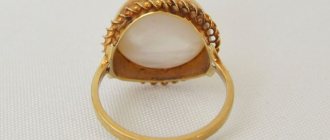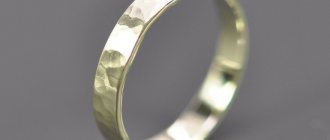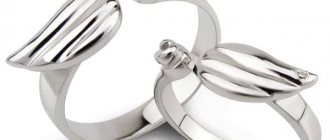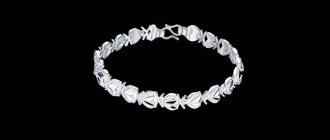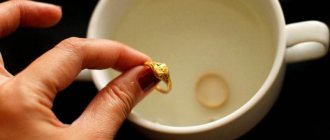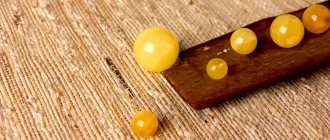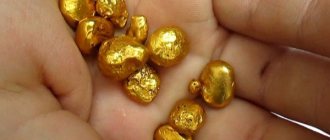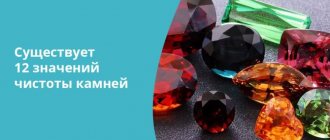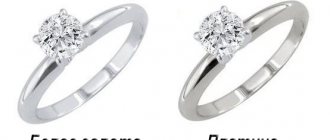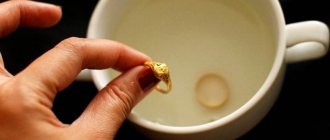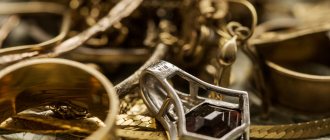Nowadays it is difficult to surprise anyone with a counterfeit product. Absolutely everything is counterfeited - from food to money, jewelry and works of art. And it is counterfeit jewelry that costs buyers the most. According to average statistical data, in Russian jewelry stores, imitation of the old precious metal - gold - already reaches half of the total number of products presented. And an imitation of an old gold product will definitely cost more than fake newfangled jewelry. How can you buy a real product made from old gold, and not a cheap alloy that looks like a noble metal?
What alloys are similar to gold?
To understand how to distinguish a gold-like material from a real precious metal, you need to know which alloys can mimic the appearance of old gold. If you're unlucky, you can buy one of the following alloys:
- Aluminum bronze. It is a golden-yellow alloy. Perfectly imitates gold. Approximately 90% of this alloy is copper, the rest is aluminum.
- Butt bronze. It also has a beautiful golden yellow hue. Usually used for the manufacture of various artistic products. Unscrupulous sellers may pass it off as precious metal to gullible buyers.
- Batmetal. In some countries, tableware is made from it. This alloy imitates gold quite well.
- Belgium. This alloy is more similar to platinum. Includes iron, nickel and chromium. There is no hint of precious metal.
- Vermeil is silver processed by fire. During processing, the metal becomes similar to gold. But paying as much for silver as gold costs is not the best option.
- Hameltonmetal is an alloy of zinc and copper. It has a beautiful golden yellow hue. It is used for gilding of various products.
- Goldin. It is an alloy of aluminum and copper. In some countries, budget jewelry is made from it. Although the metal is beautiful, it has nothing in common with gold except its appearance.
- Durametal. This alloy consists of aluminum, copper and zinc. The ingredients are mixed in certain proportions and subjected to special processing. The final product has a beautiful golden-bronze hue. But again, this is not gold.
- Gold leaf. These very thin sheets are used for gilding a variety of wooden and metal products, as well as in other areas.
- Musiv is a sulfide tin with an attractive golden luster. Typically used for gilding. Its only advantage is that the material does not turn black over time.
- Mannheim gold. It is an alloy of zinc, copper and tin. It has a “gold” coloring.
- Mosaic gold. This alloy consists of zinc and copper. It has an original shade of native gold.
- False gold is an alloy of copper with a layer of precious metal.
- Oraide. This alloy consists of zinc, copper and tin. Sometimes iron is added. Used for casting inexpensive jewelry.
- Pinchbeck, which is an alloy of zinc and copper. Used for the production of budget jewelry. Passed off as gold by unscrupulous traders.
- Platinor is an alloy of silver, copper, nickel, zinc and platinum. The percentage of precious metals is so small that unscrupulous sellers stand to gain big by passing off such items as real gold.
- Similor. This alloy contains zinc, copper and tin. Usually the products are plated with gold.
- Tompak is one of the alloys most often passed off as gold. It contains zinc and copper. Has a beautiful shade. Thanks to copper it is resistant to corrosion.
- Electron. It contains silver and gold. In ancient times, the alloy was used to make coins.
Close relatives of pyrite in physical and chemical properties. What minerals can be confused with pyrite
In terms of chemical, physical properties, as well as external characteristics, pyrite has so-called brothers - related minerals. They can easily be confused with each other.
Chalcopyrite. This is also a mineral, but it has a darker, intense yellow tint, giving off a reddish tint. This is due to the large proportion of copper in the stone. Hardness is lower: 3.5-4 on the Mohs scale.
Cobaltine. A mineral containing cobalt and iron. Softer than pyrite: its hardness is 3.5. Differs in color: from white to dark gray.
The meaning of jewelry hallmark
It is important to consider that even the presence of a sample does not guarantee that you are buying a precious metal.
If with Russian markings the buyer is still a little clear (usually these are numbers next to a female profile or a star and a hammer and sickle), then with samples according to foreign standards everything is much more complicated. And the knowledge that 14-carat gold corresponds to the “domestic” 585th standard, and a product made of 18-karat material can be regarded as 750th standard, practically does not help in the matter. Samples are samples, but no one is safe from buying a chain, of which, at best, half is made of precious metal, and the rest is made of various kinds of alloys.
It is very difficult to verify authenticity. Not every jewelry detector responds. When going to the store to buy a gold item, take with you some jewelry made of the same material. Throw your product and the product you are looking at into the display case and compare the sound it makes. If the sounds are similar, you've likely struck real gold.
Psychological methods can also be used. Try to “pick” the surface of the product you are looking at a little so that the consultant can see it. You won’t do anything bad to the product, but you can understand a lot from the seller’s reaction.
How to recognize a fake?
Since there are now a lot of fakes that look very much like gold, show them to a specialist when purchasing. If it is not there, then look at the sample and carat weight. Although this method will not always help, since they are now testing fake jewelry as well. Inspect the item if you see any wear on the edges and if it is fake, you may notice other metal.
Since ancient times, gold has been tested by tooth: if you bite it lightly, traces will remain on it, but on a fake it will not, unless lead is added to the alloy. If you put gold in a plate with vinegar, the fake will immediately darken. You can also check with iodine: if you drop it on the jewelry, the fake will darken, but the gold jewelry will not change its appearance. There is a special pencil in medicine; if you run it over the product, the fake will darken. Some counterfeits can be detected using a magnet.
In order not to fall for the tricks of scammers, purchase gold from reputable or verified stores. Avoid buying jewelry in passages, stalls, and online stores. Contact professionals to verify the authenticity of the product, its quality and value.
As we can see, many alloys are similar in appearance to gold, which is passed off as real jewelry. When purchasing, be careful not to purchase a fake that has nothing to do with gold. You can purchase a high-quality fake that is indistinguishable from the original. Nowadays, counterfeits that imitate gold are a profitable business for fraudsters and smugglers. Check the products you buy. Happy shopping!
Jewelry quality assessment
Checking the quality of jewelry products in Russia falls under the authority of the State Assay Office. Theoretically, products with its hallmark are real gold. However, in practice everything is much more confusing. The problem is that most jewelry is checked superficially. Typically, only the layer of coating scraped from the surface of the jewelry is analyzed. Thus, the seal only indicates that the top layer of the jewelry is actually made of gold. But what is underneath this layer is already a mystery.
A knowledgeable user might argue that precious items are cut, after which the cut is subjected to detailed chemical analysis. Yes, it is. But only one product from a whole batch of the same type undergoes such testing. So if the tested sample is made of gold, and the rest of the products are made of unknown alloys, the assay office is no longer responsible for this.
It is also important to take into account that only about half of the products in the country are currently labeled accordingly. If we take into account the specifics of the activities of the mentioned assay office, we can come to the disappointing conclusion that there are even fewer high-quality jewelry on sale.
And there is nothing surprising about this. Counterfeiting jewelry is very profitable. They are small in size and sell for a high price per unit volume. It is very convenient for smugglers to work with such products. Their production does not require large production facilities. And complex technological operations, as a rule, are also not required. So the shadow jewelry business is developing and thriving. Therefore, you need to carefully prepare for your purchase.
Where is pyrite mined? Russian deposits
It is important that there are no pure pyrite deposits. Fool's gold is not so expensive and valuable, so it is mined only together with other rocks and metals. Pyrite is often present in ores next to gold. Found together with nickel, cobalt, copper. The largest Russian deposits:
- Ural: Kalatinskoye, Berezovskoye, Degtyarskoye gold ore deposits;
- Magadan region, city of Susuman;
- Altai and Caucasus mountains.
In addition, pyrite is found in deposits of marine clays and brown coal, which are found in Central Russia. Numerous factories are engaged in the processing of mineral rock, for example, in Yekaterinburg and Rostov.
Mineral mining
Esotericists about the magical effect of pyrite jewelry on the human body
The use of pyrite is possible for magical purposes, esotericists say. This is a favorite crystal of psychics and magicians. It is believed that it is able to accumulate and preserve vital energy. Many psychics, after practical sessions, use this stone for recovery; they receive magical power through it.
Pyrite nugget
It is important to use the perfect mineral without cracks or chips. It is advisable to use pyrite as a talisman in the following cases:
- when a person takes risks or is in danger, for example, police officers, firefighters, rescuers;
- The mineral is suitable for leaders and strong personalities;
- The stone protects families.
Magicians claim that pyrite is a masculine mineral. It can make a person strong, fearless, and instill confidence in him. There is also an opinion that this stone warns of dangers, misfortunes, death: it becomes cloudy.
The crystal is also useful to some extent for women. Helps arrange personal life, preserves the child for pregnant women, facilitates childbirth, treats infertility.
A stone can also be of great importance for a child. If the baby is restless, then a piece of pyrite was hung in the form of a pendant around the neck. The stone not only gave balance and tranquility, it also improved sleep, protecting against nightmares.
The secret of the medallion.
For 250 years, the best Viennese chemists struggled to solve this mystery. The medal, which is still kept in the Museum of Art History, was scraped repeatedly. But they all showed the presence of gold, and the color was quite appropriate. Moreover, part of the medal that the monk held with his fingers remained silver.
The last experiment that put an end to this story was carried out in the last century. Through microanalysis, it was established that the medallion was made of an alloy of silver with gold and copper (43:48:7), with a small addition of iron, tin and zinc. And the metal changed color as a result of a reaction with a 50% solution of nitric acid. Today this process is actively used by modern jewelers under the name “yellow boiling”.
Methods for the formation of pyrite in nature
The origin of the mineral is explained in several ways.
When magma crystallizes during cooling
Volcanic magma, cooling, crystallizes. Hot vapors disappear, the remaining oxides form pyrite.
As a result of the interaction of hydrogen sulfide vapor, sulfur and iron-containing compounds
Pyrite can be formed by pneumalite, that is, with the participation of gaseous substances. For example, hydrogen sulfide and iron-containing substances combine with sulfur compounds to release hot fumes. They interact to form mineral rock.
